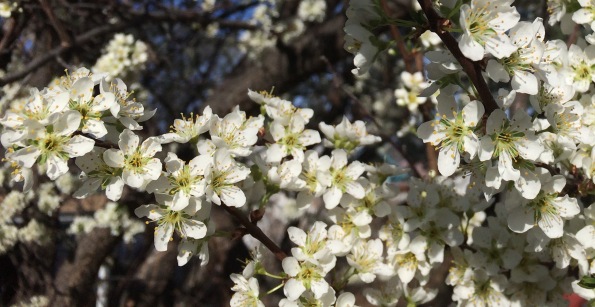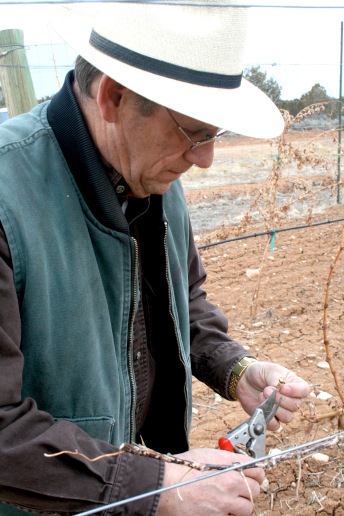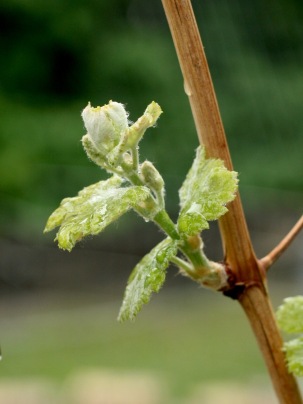Archive
It’s time for a change, but is it spring or another blast of winter?

Early heralds of the season to come, these plum blossoms may or may not survive to produce fruit, depending on the weather. Some fruit growers in western Colorado say they get plums and apricots about one year in 10. Story, photos by Dave Buchanan
A change is coming to the high desert of western Colorado. Observant hikers already have noticed miniscule blossoms poking out from desert shrubs, including such early bloomers as shadscale and saltbush.
In the city, winter-weary eyes are greeted by puffy blossoms of plum, apricot and serviceberry, glowing popcorn-white against winter-dark wood.
For fruit growers, however, this means restless nights, knowing it won’t be long until their sleep is broken by the roar of wind machines keeping the frost at bay.
Meanwhile, the vineyards sleep on. Even as eager gardeners eye emerging crocuses and dig into the cool soil as if spring were buried there, the vines wait unperturbed.
The vines are not fooled.
“Everything is still pretty much asleep,” noted Horst Caspari, state viticulturist at the CSU Orchard Mesa Research Station. “They don’t wake up very quickly. Each week they lose some of their cold-hardiness and each week they get closer to waking up.”
Caspari let his eyes wander to the apricot and pluot trees outside his window at the research station near the northwest corner of B and 32 roads on Orchard Mesa. He doesn’t harvest the fruit; the trees are there for decoration and to act as Nature’s calendar of seasons.

Winemaker Guy Drew of Guy Drew Vineyards in McElmo Canyon near Cortez in southwestern Colorado checks some early bud development in his grape vines. Growers regularly monitor bud growth and survival, looking for hints of the crop to come.
“Once the trees and vines get to bud break, all the cold hardiness changes,” he said. “Look at the apricots. I’d expect we’ll see the first flowers in the valley this week but if it drops to 29 degrees, you’ll lose them.”
Bud break, when nascent buds emerge from the protective cover and show themselves to the world, is when spring really arrives in the Grand Valley, no matter what the calendar or the thermometer says.
When a visitor remarked that his plum tree was “thisclose” to flowering, Caspari laughed.
“Well, you probably won’t have any plums to pick up this fall,” he said.
Records suggest that the last spring frosts are coming come earlier and the first fall frosts arriving later, adding a few days on each end of the Grand Valley’s growing season.
Caspari, who refers to killing frosts below 30 degrees, said that in the 54 years of records the Research Station has kept, the median date for the last frost (below 30 degrees) is April 25 while the first fall frost comes around October 23.
That’s not absolute, he emphasized.
“In 2016, we got hit pretty hard when we had 19.8 degrees on Nov. 16,” he said.
In those years, the same records indicate the valley has picked up “about a week” of frost-free (i.e., not a killing frost) growing, Caspari said.
A few days in the spring and about the same in the fall.
“We definitely have changed in the fall,” he said.
Of course, the changes are not limited to western Colorado.
NASA reports the average global temperature has increased about 0.8-degree Celsius (1.4-degrees degrees F) since 1880.
Two-thirds of that, says NASA, has occurred since 1975, just about the time U.S. wines broke onto the world’s stage at the famed Judgment of Paris.
During the 2017 Vinexpo in Bordeaux, France, growers and winemakers alike voiced concern about a warming climate and its effect on winemaking.
“Vines are very sensitive plants,” Gaia Gaja, co-owner of the 159-year old Gaja Winery in Barbaresco, Italy, told the French Press Agency. “They’re like a thermometer. They register every little variation that there is around them.”
Which brings us to spring of 2018, where things are bit behind last year.

Late March still is too early in the Grand Valley for grape tendrils but it won’t be long until delicate leaves such as these add a shade of green to brown vines.
“I keep track of the budding time of my flowers, my bulbs, and it’s been pretty fascinating,” winemaker Nancy Janes of Whitewater Hill Vineyards said recently. “It has not been unusual historically for me to have crocuses bloom in the middle of February and this year my crocuses are just blooming right now.”
She said the warm days have been balanced by nights dipping into the low 30s “and that’s keeping things pretty dormant.”
Caspari also noted that the spring so far is about two weeks behind 2017.
“Last year we had bud break in the second week of March and we don’t normally get bud break in Chardonnay until the fourth week in April,” he said.
One way to look at the spring re-awakening, said Caspari, is to envision a circle, with winter cold at the bottom and spring warmth at the top. Does the temperature rise gradually, following the arc of the circle, or is there a sudden bottom-to-top jump, bridging the gap and going quickly from winter to spring?
“That changes how you think about what you have to do to have a crop,” Caspari said.
Most grape growers are busy pre-pruning, getting ready for that last flurry of cutting and shaping when the growing season finally arrives. Will it come with a rush or will western Colorado sink back into another spell of winter, delaying the bud break and pushing development later into fall?
Nancy Janes gazed out of her winery at the still-sleeping vineyard sloping away to the north. A few clouds could be seen drifting far over the Bookcliffs in the pale, late-winter sky.
“So far, it’s been a very nice winter for us,” she said. “And you know, grapes aren’t fooled easily. They know when things are ready.”
Wineries shine like gold during Governor’s Cup competition

Judges at the 2017 Colorado Governor’s Cup Wine Competition swirled, sniffed and sipped through 346 wines during the two-day event. Among the judges pictured are, from left, Jenni Baldwin-Eaton (plaid shirt), Warren Winiarski and Wayne Belding, closest to camera. Story/photo by Dave Buchanan
The 2017 Colorado Governor’s Cup Wine Competition came and went over the weekend and of the 12 wines selected for the Governor’s Case were two white wines (including a sparkling Albariño), seven red wines, one fruit wine, one cider and a mead.
The Best of Show wine will be announced Aug. 3 when all the medal winners are celebrated at the official Colorado Governor’s Cup Tasting held at History Colorado Center, 1200 Broadway in Denver. Information here.
This year’s judging featured 324 wines from 46 wineries, a welcome jump of about 25 percent over last year in both categories but still well short of where the competition could be. Colorado now has close to 150 wineries, so less than a third of them take part in the contest.
Wineries offer many reasons for not entering this and other competitions, like they simply forget to send their applications in time or it costs too much or they don’t have the wine to spare. But just as Colorado Mountain Winefest brings Colorado wines to a diverse audience, in the end the Governor’s Cup contest is a boon to the state industry.
The 12 selected wines in the Governor’s Cup case are used to promoted Colorado and Colorado wines and are featured at state dinners and marketing events.
It’s notable to add that this year’s entries in the cider/mead category also eclipsed last year, indicating the continued growth of artisanal ciders and meads. Well, ciders, anyway.
Four ciders and three meads were selected for the final round of judging, which again raised the familiar argument of whether there should be a separate competition for the non-grape segment of the wine industry. You can argue all you want as to whether ciders and meads actually are wines or should be in their own category but you’ll get no take from this side.
Last year there was a separate six-pack case of ciders and meads selected to accompany the regular Governor’s Cup case but this year it will be a mixed case. There was some discussion about separating the judging (that’s been tried in the past with fruit wines) and having separate Best of Show awards and Governor’s Cup cases for grape wines and for cider and mead. The problem is that separation adds to the cost of the competition.
The Governor’s Cup case wines (and their respective medals) includes: Bookcliff Vineyards (2016 Riesling, double gold); Carlson Vineyards (2015 Tyrannosaurous Red, gold); Colorado Cellars/Rocky Mountain Vineyards (nv Raspberry, double gold); Colorado Cider Company (Grasshop-ah cider), double gold); Creekside Cellars (2014 Cabernet Franc, double gold); and Guy Drew Vineyards (2015 Syrah, double gold).
Also: Meadery of the Rockies (Strawberry/Honey, gold); The Infinite Monkey Theorem (2013 Albariño (sparkling), double gold); Two Rivers Winery (2013 Port, double gold); Decadent Saint the Winery (2013 Cabernet Sauvignon Reserve, gold); Whitewater Hill Vineyards (2016 Sweetheart Red, double gold) and Winery at Hold Cross Abbey (2015, Merlot, gold). The final medal total was eight double gold medals, 16 gold medals, 140 silver and 103 bronze, totally 267 medals out of the 346 entries.